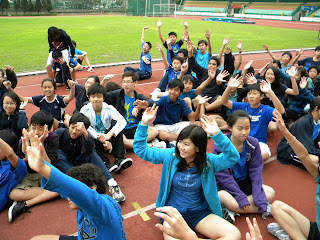
Saturday, April 17, 2010
The Great American Past Time
 Thursday morning we had a ton to do in English class. We had a homework assignment to go over, the epilogue of Night to read, a project to introduce, and more. But we set all that aside because we had something much more important to discuss: tagging up on a pop fly.
Thursday morning we had a ton to do in English class. We had a homework assignment to go over, the epilogue of Night to read, a project to introduce, and more. But we set all that aside because we had something much more important to discuss: tagging up on a pop fly.Half an hour earlier, the need for such a conversation became painfully obvious. At our school, we start each day with a forty-five-minute Advisory time which we usually dedicate to a wide variety of Christian-living or pseudo-academic topics. But two or three times a month, we teachers set up sports competitions between Advisory groups play such sports as dodge ball, basketball or –in the case of Thursday morning- kickball.
I have found that in Asia, the kids tend to take whatever pursuit they are engaged in pretty seriously. So while it was “just kickball,” everyone was pretty intense (then again, maybe it was just me who was taking it a little too seriously).
So, fresh from the kickball tournament, I decided that we could –that we should- steal fifteen minutes from first-period English to review some of the finer points of the Great American Past Time. After all, we are an American school.
Okay look gang. First of all let’s talk about tagging up on a fly ball. If it’s a pop up or a line drive . . . what? A pop-up, Natalie, you know, a kick or hit that doesn’t hit the ground. Please don’t interrupt. Okay, if you are on base and the batter –sorry, kicker- hits a fly ball, you have to wait and see whether the fielder catches the ball. If she does, you have to “tag up” on your base before proceeding. I moved the color-coded magnets around the whiteboard. Multiple times this morning, many of you were caught off base and fell victim to this rule. People, you've got to tag up on a fly ball.
Second, some of you don’t seem to know the difference between a forced out and a non-forced out. If you are in the field, and there's a runner on first, then you have a potential forced out at both first and second. If you get the ball, you have the option of either tagging the runner and or simply tagging the bag before the runner gets there. On the other hand –hey Ivan, pay attention, this is important stuff. On the other hand, if there's a runner on second only, there is no forced out at third because the runner doesn’t have to proceed. If you get the ball, you can not simply tag third base. You're going to have to tag the runner directly. Yes, Sarah, I see you there, just relax. We’re going to grade the homework in just a minute. Okay where was I? Oh yeah, just remember, if you do have runners at both first and second, then you do have a forced out option at all three bases.
Even as I am hearing myself explain all this, I realize how complicated it can be. For those of us who grew up playing baseball (and its illegitimate stepchild: kickball), these arcane rules tend to be second nature.
Julie and I originally signed up for a two-year stint in China, but I’m afraid that we may have to extend our stay. I have so much work to do here. I am determined not leave Hong Kong until all of my students know enough to tag up on a pop fly.
It’s going to take some time.
-Jack
Hey boys and girls, now that we’ve gone over the basics, let’s talk about the much-misunderstood Infield Fly Rule . . .
Closing thought: Why is it called a “past time” as in The Great American Past Time? Wouldn’t it make more sense if it were called a “pass time” as in it something we do to pass the time? Just a thought.
Wednesday, April 14, 2010
Our Most Recent Outing part 2 of 2
 When appropriate, I like to share anecdotes from my own life. One, it lets the kids know I am human (and not just a paper grading machine) and two, it lets my students know these issues have real-life application. So I briefly shared my own need to demonstrate love, patience, and grace when it became evident several years ago that one of Julie’s adult nephews was gay.
When appropriate, I like to share anecdotes from my own life. One, it lets the kids know I am human (and not just a paper grading machine) and two, it lets my students know these issues have real-life application. So I briefly shared my own need to demonstrate love, patience, and grace when it became evident several years ago that one of Julie’s adult nephews was gay.I was two sentences into my little monologue when I saw twenty-four sets of eyes swing toward the center of the classroom and come to rest on a certain fourteen-year-old blonde. She was frozen in her seat. Suddenly, in the middle of my lesson I remembered that there was something that I had been meaning to do. What was it? Change the oil in the car? Get those pants hemmed? Oh yeah, now I remember: bring Annika up to speed on her cousin’s sexual orientation.
Yup, I had just outed my nephew to my daughter in front of twenty-four of her nearest and dearest friends.
It was just a teensy bit awkward. While I was busy looking for the rewind button, Annika was looking for that elusive hole in the ground.
I realized that I hadn’t referred to my nephew by name and I could see that Annika was mentally scrolling through her long list of cousins. So across the crowded classroom I stage whispered my nephew’s name. It didn’t appear to clear up any of her confusion and bewilderment.
Her fellow classmates starting “oh”-ing as they watched this little mini-family drama unfold in the middle of first period on a Thursday morning.
This was a conversation that I had been meaning to have with Annika. I just never imagined it unfolding quite like this.
I’m pretty sure she didn’t either.
Oops.
That’s what I get for trying to function on five hours sleep.
-Jack
Our Most Recent Outing part 1 of 2
 (posted with permission)
(posted with permission)Annika is in my literature class. For the first week of school it was a little weird but then we settled into a routine and it hasn’t really been a big deal.
Until last Thursday, that is.
First, that morning was the last day of our human sexuality unit in my small advisory group. We briefly touched on issues surrounding same-sex attraction. I concluded our small-group advisory time together by reminding students that we want to emulate Jesus by loving and showing grace to all people in our lives no matter what journey they are on.
Then, during first-period literature, my students and I continued our study of “Night” by Elie Wiesel, a Jewish Holocaust survivor. Hitler, of course, targeted not only Jews, but Roma (gypsies), homosexuals, the handicapped, and communists.
I'm always looking for opportunities to tie together various parts of the curriculum. Because the topics overlapped, I used the opportunity to share with this group of students what I had said to my advisory students earlier: no matter our politics or theology- we are to fully love the people in our lives as Jesus modeled for us.
Sunday, April 11, 2010
What are the Chances? part 2 of 2
 Because of the rain, we break early for lunch. The food being sold near our beach is just a tad too local for our comfort level. While Julie and the girls seek refuge under a tarp strung between two huts and pair of palm trees all the while fending off several women hawking jewelry made from seashells, I walk down the beach looking for food that’s –how shall I say it?- not quite so local. I finally bump into a lone westerner –a tall, bald guy about my age. He directs me another 100 yards down the beach to a small open-air restaurant.
Because of the rain, we break early for lunch. The food being sold near our beach is just a tad too local for our comfort level. While Julie and the girls seek refuge under a tarp strung between two huts and pair of palm trees all the while fending off several women hawking jewelry made from seashells, I walk down the beach looking for food that’s –how shall I say it?- not quite so local. I finally bump into a lone westerner –a tall, bald guy about my age. He directs me another 100 yards down the beach to a small open-air restaurant.Ten minutes after the four of us are seated in the restaurant, in walks Tall Bald Guy, his wife, two young sons, and Bald Guy's parents. They sit down two tables away. We are the only customers at this restaurant; in fact, we are probably the only Americans on this tiny spit of an island.
As is wont to happened, we got to talking. We started exchanging the what's and where's of our respective autobiographies. And then it clicked. After just two or three minutes of the basics, I had gathered just enough information for the pieces to fall into place.
Six billion people on the planet, 330 million Americans, and –yup- I am sitting two tables from Rodney Winslow’s brother and mom and dad.
What are the chances?
Subscribe to:
Comments (Atom)














